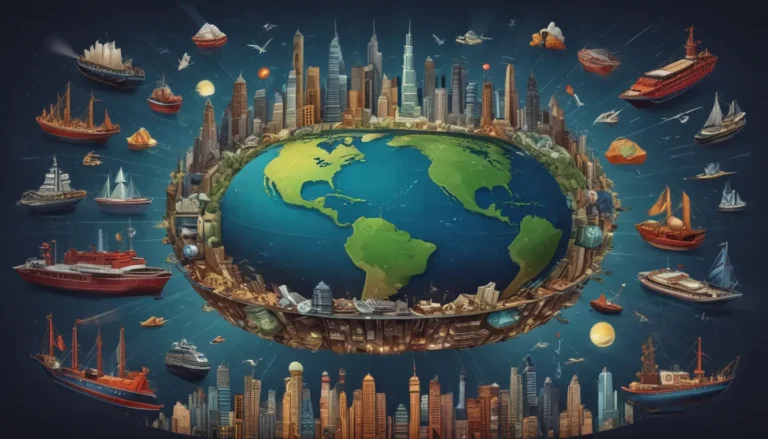A Note About Images: The images used in our articles are for illustration purposes only and may not exactly match the content. They are meant to engage readers, but the text should be relied upon for accurate information.
Isthmuses, those narrow strips of land connecting continents and separating bodies of water, are like natural bridges that play a vital role in shaping our world. From fostering biodiversity to influencing global trade, these geographical wonders have captivated explorers, scientists, and geographers for centuries. Let’s embark on a journey to unravel the mysteries and marvels of isthmuses as we explore eight enigmatic facts that will leave you in awe.
The Role of Isthmuses in Connecting Continents
An isthmus acts as a natural bridge connecting two larger land masses, allowing the exchange of flora, fauna, and cultures between continents. For instance, the Isthmus of Panama serves as a link between North and South America, facilitating the movement of species and ideas.
The Iconic Isthmus of Suez
Arguably the most famous isthmus globally, the Isthmus of Suez connects Africa to Asia and hosts the critical Suez Canal. This waterway has revolutionized global trade by providing a shortcut between the Mediterranean Sea and the Red Sea, reducing travel distances and enhancing maritime transportation.
Biodiversity Hotspots: Isthmuses as Ecological Corridors
Isthmuses are biodiversity hotspots, serving as corridors for the migration and dispersal of various plant and animal species. These narrow land bridges offer unique habitats and ecological niches, fostering the evolution of diverse and often endemic flora and fauna.
Human Engineering Marvels Transforming Isthmuses
Throughout history, humans have employed engineering marvels to transform isthmuses for economic and strategic purposes. One notable example is the Panama Canal, which enables ships to traverse between the Atlantic and Pacific Oceans, significantly impacting global maritime trade.
Volcanic Origins: Nature’s Fiery Contribution to Isthmuses
Some isthmuses owe their existence to volcanic activity, where eruptions deposit vast amounts of volcanic material over time, creating land bridges. The Isthmus of Kra in Thailand is believed to have formed through volcanic processes, showcasing nature’s fiery contributions to geographical formations.
Strategic Significance: Isthmuses in Human History
Isthmuses have long held strategic importance in human history, coveted by empires for their military and economic advantages. Serving as significant trade routes and defensive positions, isthmuses have shaped geopolitical dynamics and influenced the course of civilizations.
Vulnerability to Natural Disasters: Challenges Faced by Isthmuses
Due to their narrow and exposed nature, isthmuses are often vulnerable to natural disasters such as hurricanes, tsunamis, and earthquakes. These events pose unique challenges for the people and ecosystems inhabiting these regions, highlighting the need for resilience and preparedness.
Modern Threats to Isthmuses: Conservation Imperatives
In the modern era, isthmuses face numerous threats from urbanization, industrialization, and climate change. Human activities such as land reclamation and deforestation can disrupt the delicate ecological balance of these regions, emphasizing the importance of conservation efforts to preserve these valuable land formations.
Exploring the Diverse Realms of Isthmuses
In conclusion, isthmuses are not mere land bridges but intricate geological, ecological, and historical wonders that enrich our understanding of the world. The eight enigmatic facts about isthmuses discussed in this article shed light on their diversity and significance, from engineering feats like the Panama Canal to the unique ecosystems they support.
FAQs: Unveiling More Insights on Isthmuses
- What is an isthmus?
-
An isthmus is a narrow strip of land connecting two larger land masses, typically surrounded by water on two sides.
-
How are isthmuses formed?
-
Isthmuses are formed through geological processes such as sediment deposition, erosion, or tectonic activity.
-
Are isthmuses significant for trade and transportation?
-
Yes, isthmuses play a crucial role in providing shortcuts for trade routes and transportation, reducing travel time and costs.
-
Which isthmus is renowned for its impact on global trade?
-
The Isthmus of Panama, particularly with the construction of the Panama Canal, is historically renowned for its impact on global trade.
-
Do isthmuses support unique ecosystems?
-
Yes, isthmuses often harbor diverse ecosystems due to their geographical location, facilitating species migration and genetic exchange.
-
Are there famous landmarks located on isthmuses?
-
Yes, landmarks like the Corinth Canal in Greece are located on isthmuses, showcasing breathtaking engineering feats.
-
Can isthmuses act as natural barriers?
-
Yes, isthmuses can serve as natural barriers, separating bodies of water and creating distinct ecosystems on either side.
-
Have ancient civilizations developed on isthmuses?
- Yes, ancient civilizations like the Mayans in the Yucatan Peninsula and the Incas in Peru have thrived on isthmuses, utilizing their strategic locations for settlement.
Isthmuses are not just geographical features; they are connectors of lands, cultures, and histories, offering a glimpse into the intricate relationships between land and sea. By exploring the mysteries and wonders of isthmuses, we can deepen our appreciation for the Earth’s diverse geography and the remarkable interplay between nature and human endeavors.






